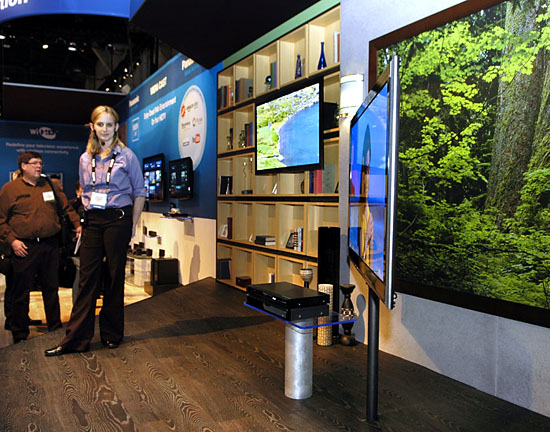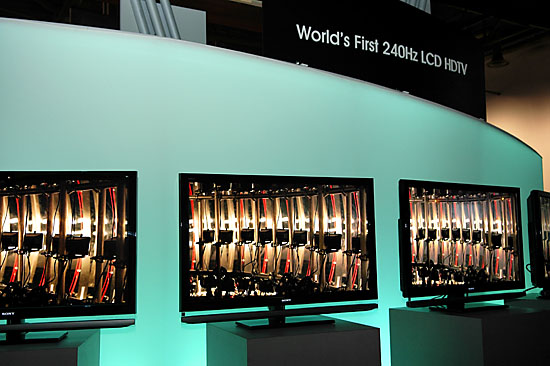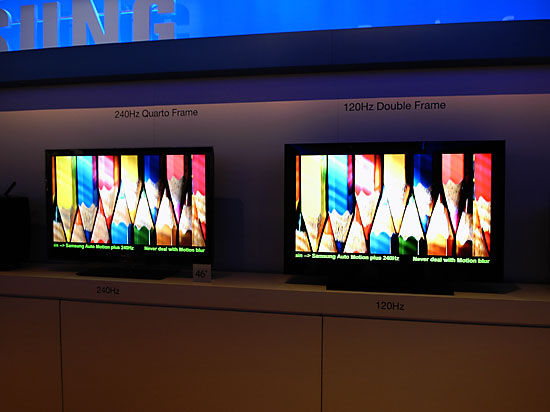CES 2009 - TV Trends, WirelessHD, 240Hz and Netbook Pricing
by Anand Lal Shimpi & Manveer Wasson on January 12, 2009 12:00 AM EST- Posted in
- Trade Shows
More TV Trends: Thin, Local Dimming and 240Hz

Panasonic demonstrated a 1” thick plasma display as well as a prototype 1/3” plasma at this year’s CES.

Thin is in. WirelessHD should eventually help reduce the thickness of TVs as well.
We also saw a brightness and power consumption demo similar to what was shown off last year. In short, brightness per watt is improving with newer panels over older ones. If you have a plasma or LCD that’s only 3 or 4 years old, you’ll most likely see a huge improvement either in brightness or power consumption (or both) by moving to a newer panel.
The LCD vs. Plasma debate basically boils down to this: LCDs have brighter whites and plasmas have deeper blacks (there’s also the glare issue but let’s ignore that for now). Given the lower cost of LCD panels at smaller, more mainstream sizes, TV makers are often looking for ways to improve black levels without sacrificing white levels.
If you could control the backlight of individual areas of the panel, you could turn it off completely in dark areas and leave it on in white areas. The concept and technology has been around for a while, but what we needed was rear-lit LED backlighting to make it affordable.
Instead of the panel being lit from the sides, with a rear-lit (or full matrix) backlight it’s illuminated from behind using many LEDs. With a true backlight composed of many LEDs it’s easy to dynamically turn on/off groups of them depending on the scene. The result is better black levels without sacrificing the bright whites that make LCDs so desirable. We saw similar technologies demonstrated last year in the Panasonic and Pioneer plasmas at CES 2008.
Another potential benefit of full matrix LED backlighting is what Toshiba and some other manufacturers are calling the 240Hz effect. Last year we saw the beginnings of a move to 120Hz LCDs, which you may remember isn’t LCD panels with 120Hz refresh rates. There are only 60 frames of data displayed, the data in between two frames is simply interpolated on the fly effectively giving you 120 frames per second (but from only 60 frames worth of data).

The 240Hz panels don’t interpolate a second time, instead some use a technique called backlight scanning. You still perform the same 120Hz effect but you turn portions of the backlight on and off very quickly to make for 240 different frames per second. Sets that support 240Hz in this manner obviously can also support local dimming, but it’s unclear if they can do both at the same time.

Samsung uses interpolation on its 240Hz TVs
Some manufacturers are interpolating a second time, so you get one original frame and 3 interpolated frames, at a rate of 240Hz without doing any backlight trickery. On paper this sounds like a better implementation however the displays that use additional interpolation also lack local dimming. Both Samsung and Sony generate 240 frames using interpolation and both companies use edge-lit LED backlights. Interestingly enough, Samsung used a rear-lit LED backlight in last year’s model with local dimming support and moved away from it this year.

OLED TVs were at CES, but still not ready for mainstream consumption yet
Internet Enabled TVs
We saw streaming internet content in CE products in early forms at last year’s CES. This year, companies have forged partnerships with the likes of Netflix, YouTube, and Yahoo in order to provide content directly to TVs and Blu-Ray players. Unfortunately, each CE company has forged alliances with different content providers. So while Sony can provide you with YouTube and Amazon Video streaming, it will not provide streaming HD Netflix movies like LG and Samsung can.
Although the idea of not needing to hook up a PC to your TV to view your favorite YouTube videos is nice, locking content providers to specific CE companies certainly hinders its usefulness. Streaming content is probably not a deal breaker for most consumers’ CE purchases.










30 Comments
View All Comments
Jaybus - Tuesday, January 13, 2009 - link
I doubt they chose the 60 GHz band just to avoid copyright problems. It is because of the bandwidth that they needed. 250 Mbps is not nearly enough. HDMI 1.0 specifies 4.9 Gbps for uncompressed transmission of 1080p60Hz plus 8-chan audio. HDMI 1.3 upped it to 10.3 Gbps to allow for higher resolutions. WirelessHD has a 7 GHz bandwidth on a 60 GHz carrier to achieve a max of around 25 Gbps. You obviously can't have a 7 GHz bandwidth with only a 5 GHz carrier frequency, so the carrier frequency had to be high to truly do HDMI wirelessly. Now why they chose 60 GHz as opposed to say 40 GHz may be because of transmission distance.Galvin - Monday, January 12, 2009 - link
4K LCD's scare me that just increases your chance of dead pixels by 2x. The sooner FED/SED tech is out the better. Cause that tech doesn't need all the fancy back lighting of LCD to handle blacks/whites.Plifzig - Monday, January 12, 2009 - link
Even worse, it increases your chances of getting dead pixels by 2X in the horizontal AND 2X in the vertical. Overall it's a 4X chance increase!2,073,600 pixels vs. 8,294,400 pixels
Denithor - Monday, January 12, 2009 - link
And can you imagine the GPU required to push a game for that resolution?SlyNine - Tuesday, January 13, 2009 - link
Geforce 256 SDR ?? ;)3DoubleD - Monday, January 12, 2009 - link
"Another potential benefit of full matrix LED backlighting is what Toshiba and some other manufacturers are calling the 240Hz effect. Last year we saw the beginnings of a move to 120Hz LCDs, which you may remember isn’t LCD panels with 120Hz refresh rates. There are only 60 frames of data displayed, the data in between two frames is simply interpolated on the fly effectively giving you 120 frames per second (but from only 60 frames worth of data)."Anand, this is one implementation of 120 Hz technology, but I fear it is the incorrect one. Many (if not all) TV manufacturers are producing TVs that use interpolation on 120 Hz TVs. This feature primarily targets sports as many complain about blurring while watching their favorite fast paced games on their several thousand dollar LCD TVs. This is the only time interpolation should be implemented as the effect is rather sickening for movie content. Interpolation of movie frames gives a rather "home video, handycam" sort of feel, completely ruining the experience.
120 Hz was used to allow both movie and tv content to be viewed without performing an uneven pulldown. On most TVs in the past, 24 Hz content (from Blu-rays, HD DVDs, and properly encoded movies and TV shows on the internet) required a 2:3 pulldown to be shown at 30 Hz and then doubled to the 60 Hz refresh rate of your TV to eliminate flickering. Unfortunately, the 2:3 pulldown isn't perfect and you get a phenomena called telcine judder or motion interpolation. This is very obvious during slow panning scenes, where the panning motion does not seem smooth, but jumps. The only way to properly handle 24 Hz material is to display it at a refresh rate at an even multiple of 24. Thus there are two options: offer two possible refresh rates on your TV (60 Hz and a multiple of 24 but greater than 60 (72 Hz or 96 Hz)), OR offer one refresh rate at 120 Hz as it is divisible by both 24 and 30 Hz.
TVs such as the Pioneer Kuro line offer the first implementation, where 60 and 72 Hz refresh rates are available. Most LCDs above ~$1500 CAD offer 120 Hz. With most of these 120 Hz LCDs, interpolation can be turned off for proper movie viewing. With all of this said, a TV that has a 240 Hz refresh rate is completely useless as 120 Hz solves the problem of displaying both 24 and 30 Hz content as well as offering interpolation for keen eyed sports fans.
However, the general public will never understand this... so let the Mhz wars begin (again)
Holly - Sunday, January 18, 2009 - link
You forget one thing... These 240Hz screens might be also inteded as a first step to shutter-glass aided 3D screen simulation. Giving each eye 120Hz is about reasonable refresh rate not to tire the eyes too much.strikeback03 - Monday, January 12, 2009 - link
If you turn off interpolation, wouldn't that leave 60Hz as the only option? Which would still not provide a multiple of 24 for movies.3DoubleD - Monday, January 12, 2009 - link
When you turn interpolation off it should due a 5:5 pulldown, which is simply playing the same frame 5 time in a row. However, some TVs don't do this and they should be avoided. This is something everyone should look for when shopping for a TV. Most TVs with 120 Hz capabilities have off-low-medium-high settings for their interpolation3DoubleD - Monday, January 12, 2009 - link
and by "due" I mean "do"... time for the afternoon coffee